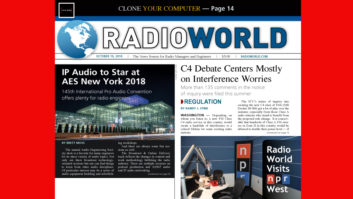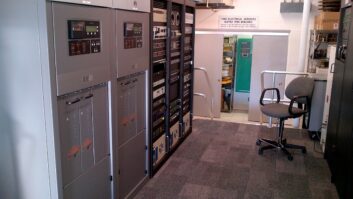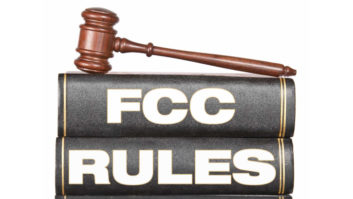WASHINGTON — Depending on whom you listen to, a new FM Class C4 radio service in this country would create a landslide of interference or a critical lifeline for some existing radio stations.
The FCC’s notice of inquiry into creating the new C4 class of FMs (MB Docket 18-184) got a lot of play over the summer, especially from those Class A radio stations who stand to benefit from the proposed rule change. It is conceivable that hundreds of Class A FM owners in Zone II in this country would be allowed to double their power level — if the FCC pursues a rulemaking and eventually adopts it.

What the FCC decides will depend, in part, on what the commission heard from the radio industry this summer. The FCC C4 proposal, which would allow eligible Class A FM radio stations to upgrade from 6,000 to 12,000 watts, drew more than 135 comments and of those “over 100 small broadcasters have commented in favor,” according to Matt Wesolowski of SSR Communications, who prompted the FCC NOI on C4 in the first place with a petition in 2014. Other commenters suggest slight changes to the proposal.
SSR estimates 210 Class A FM stations could easily be upgraded using the proposed procedures and another 10 Class A FM CP’s could be eligible.
It’s clear from comments filed with the FCC that the lines being drawn on both sides are deep and arguments passionate.
If the FCC opens a C4 FM rulemaking, it will do so against the wishes of the National Association of Broadcasters. The group is on record as being against the idea and says such a change would bring additional interference to the band following the rapid expansion of FM translators.
The NAB and others in the industry have also expressed concern about another part of the NOI, a triggering system that could result in Class A stations with under-maximum facilities being involuntarily reclassified.
In reply comments to the C4 NOI, NAB wrote, “Both proposals should be dismissed because they will reduce the technical integrity of the FM band at a time when broadcasters already face interference that hinders service and their ability to compete in an increasingly crowded audio marketplace.”
It’s not clear if FCC Chairman Pai is as eager as he once appeared to be to move the football down the field for C4. He sparked the hopes for the creation of the new class with comments he made at the 2016 Radio Show in Nashville, Tenn.
Pai, a commissioner, but not yet chairman at the time, said that C4 was an idea worth considering, and he wished the commission would take the next step in the administrative process and issue a Notice of Proposed Rulemaking.
RURAL SUPPORT BASE
A Radio World review of C4 comments shows broad support for the idea from FM stations in rural and small towns. Many of the comments are from existing Class A stations hopeful about upgrading facilities and taking advantage of the new radio service. Most urge the FCC to consider the proposal seriously without delay.
“KZYQ(FM) is a Class A FM facility licensed to a very small rural community in southeast Arkansas. While we serve thousands of acres of farmland, people are scarce. Enabling us to increase our power would improve our service to the nearby communities of Lake Village, Ark.; Dermott, Ark.; McGehee, Ark.; and Greenville, Miss.” wrote Larry Fuss, president of Contemporary Communications, which owns KZYQ.
THE COMMUNITY SERVICE ANGLE
The most popular phrase found in many of the pro comments was an ability to “better serve the community” with a bigger signal.
Vernon Floyd, owner of Circuit Broadcasting Company, commented, “WJMG is the Class A station in our group, and listeners regularly call the station asking if there is a way we could increase our coverage. This is the exact opportunity that we have needed for so long.
“Circuit Broadcasting Company is one of several 100-percent African-American owned broadcast companies in Mississippi, but one of the only such companies with multiple stations. As such, I can say with confidence that our stations will benefit from this proposal.”
The Multicultural Media, Telecom and Internet Council, which was a co-petitioner of the FM Class C4 proposal in 2014, supports the current C4 proposal and points to the number of minorities among Class A licensees as a reason the commission should move forward.
“In MMTC’s experience, doubling the stations’ power would add considerably to the stations’ asset values, thereby facilitating the licensees’ ability to attract investors, qualify for loans, and ultimately to be sold at competitive prices if the owner seeks to gravitate her station portfolio into larger markets,” it commented.
Guaranty Media President/CEO Flynn Foster told the FCC that small broadcasters, like his three Class A radio stations in Louisiana, need the relief C4 would bring.
“Our broadcasting company has been family owned in Baton Rouge since 1964. Our commitment to our community has never been stronger, and we wake up every day with a servant’s heart. We have won numerous awards for our efforts and continue to serve listeners during hurricanes, (too many to name), and civic crises (too many to name) and much more,” Foster wrote.
Numerous commenters mentioned the desirability of improved coverage area, including Mark Jones of Lendsi Radio LLC, owner of WVBG(FM) in Redwood, Miss.
The C4 proposal “would help the coverage of our station. We are in a very hilly terrain. Our station is the only locally owned media in our area, and we provide local news, weather, public service announcements, broadcast pubic high school football,” Jones wrote. “We also do one of Vicksburg’s biggest local events, the Christmas Caroling Contest, which draws thousands and awards over $10,000 each year to local school choirs and individuals.”
BIG BROADCASTERS CHIME IN
Big and small broadcast groups have weighed in with opinions on C4, including iHeartMedia, which did not oppose the FM Class C4 part of the proceeding. But Beasley Media Group agreed with the NAB’s assertion that creation of C4 FM would result in “further congestion of the FM band and an increased risk of interference to FM translator stations” in particular.
NAB said in its comments that the “SSR proposal could be especially problematic for FM translators, which are a critical component of radio service.”
NAB continued, “As a secondary service, translators are not entitled to interference protection to or from primary full power FM station, such as a new Class C4 station.”
Educational Media Foundation offered “cautious support” of a Class C4 radio service but does not support further liberalization of the rules to allow for the creation of more short-spaced radio stations.
EMF, which holds licenses for 300 full-power noncommercial educational radio stations along with a similar number of FM translators, notes, “there will be some disruption to FM translators, so the FCC must provide such translators with as much flexibility as possible to relocate to new channels or otherwise address any interference which is created.”
Low-power FM advocate REC Networks believes certain parts of the country with limited FM service would benefit from a power upgrade, even though it notes “there is a large number of Class A stations currently operating well under maximum facilities due to various reasons.”
REC Networks describes Class A as a “catch-all” service class and questions “how many Class A FM stations will be able to upgrade because of the nature of some Class A stations as well as the expense and logistics behind converting to directional facilities, especially for smaller and minority-owned stations.”
REC continues, “To reduce the impacts of the Class C4 service class on the LPFM service, REC is proposing that LPFM stations be permitted to protect Class C4 at the same co- and first-adjacent channel distances as LPFM stations protect Class A stations. This can be done in complete statutory compliance with the Local Community Radio Act.”
Wesolowski, the original petitioner to the FCC for the C4 radio service, told Radio World last month (Sept. 26 issue) that, while the NAB claims the proposal could be problematic for FM translators, “beyond some simple statements of conjecture to that effect, no hard data, case study, or evidence of any type is to be found to support that notion.”







